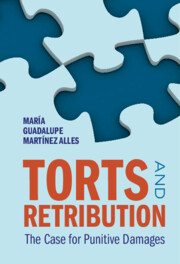Book contents
- Torts and Retribution
- Torts and Retribution
- Copyright page
- Dedication
- Epigraph
- Contents
- Preface
- Acknowledgments
- Introduction
- Part I The Place of Punishment in Torts
- 1 Punishment Is Part of Tort Law
- 2 Punishment in Tort Theory
- Part II The Retributive Rationale
- Part III Retribution in the Mass-Market Setting
- Part IV Why Tort Law
- Bibliography
- Index
2 - Punishment in Tort Theory
from Part I - The Place of Punishment in Torts
Published online by Cambridge University Press: 09 August 2025
- Torts and Retribution
- Torts and Retribution
- Copyright page
- Dedication
- Epigraph
- Contents
- Preface
- Acknowledgments
- Introduction
- Part I The Place of Punishment in Torts
- 1 Punishment Is Part of Tort Law
- 2 Punishment in Tort Theory
- Part II The Retributive Rationale
- Part III Retribution in the Mass-Market Setting
- Part IV Why Tort Law
- Bibliography
- Index
Summary
The perceived threat of punitive elements in tort law to the long-standing distinction between private and public law is so powerful that tort theorists have generally responded by depicting punishment as an anomaly. They have corseted punishment within tort law’s rectificatory framework, equated punishment with deterrence, and squeezed the victim’s standing to demand punishment into a legal power for private redress. This chapter takes a close look at these guarded reactions from tort theorists to the question of punishment and how they explain not only the scarcity of theoretical reflection on the place of retribution in tort law but, additionally, the unsuitability of those theoretical reconstructions for a productive delineation and justification for the punitive, compensatory, and deterrent dimensions of the law of torts. The chapter ultimately argues that this gap in tort theory should be addressed by seeking a place for punishment in tort law that is neither constrained by the traditional treatment of punishment as an “anomaly,” as “compensation,” nor as a corollary regulatory mechanism whose exclusive aim is “deterrence.”
Keywords
Information
- Type
- Chapter
- Information
- Torts and RetributionThe Case for Punitive Damages, pp. 50 - 82Publisher: Cambridge University PressPrint publication year: 2025
Accessibility standard: WCAG 2.0 AA
Content Navigation
Allows you to navigate directly to chapters, sections, or non‐text items through a linked table of contents, reducing the need for extensive scrolling.
Provides an interactive index, letting you go straight to where a term or subject appears in the text without manual searching.
Reading Order & Textual Equivalents
You will encounter all content (including footnotes, captions, etc.) in a clear, sequential flow, making it easier to follow with assistive tools like screen readers.
Structural and Technical Features
You gain clarity from ARIA (Accessible Rich Internet Applications) roles and attributes, as they help assistive technologies interpret how each part of the content functions.
